Guided Trail Home | Locations | Geology | Vegetation | Wildlife | Wellness | Photography Tips
Wildlife
The Snake River Canyon is a great place to see wildlife. More than 142 species of birds have been documented in Southern Idaho. Pick up a birding or wildlife checklist at the Visitor Center.
Common Name: Red-Tailed Hawk
Scientific Name: Buteo jamaicensis
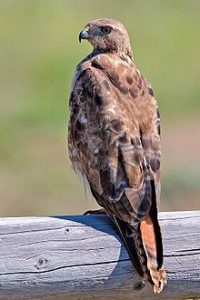
The Red-Tailed Hawk is the most common roadside raptor across much of North America. It often perches atop telephone poles, light posts, and edges of trees. It displays an incredible variation in plumage, including less common dark morphs and various regional differences. Eastern adult Red-Tailed Hawks have a brilliant reddish-orange tail and pale underparts with an obvious band of dark marks across the belly. Western Red-Tailed Hawks are typically darker. Immature hawks do not have a red tail. Most commonly seen in Spring/Summer.
Common Name: Red-Winged Blackbird
Scientific Name: Agelaius phoeniceus
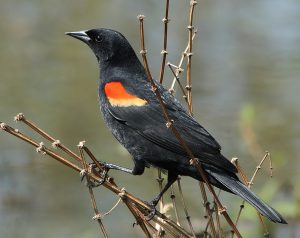
Male Red-Winged Blackbirds are black with red shoulder patches that are sometimes concealed. Males have rusty feather edges in the winter. Females are streaked brown and often confused with sparrows. When trying to identify a Red-Winged Blackbird, look for a long, sharply pointed bill. They often travel in flocks, especially in winter. Red-Winged Blackbirds typically breed in marshes and scrubby, wet fields. They have a very distinctive song, especially as migrants arrive in early spring. Most commonly seen and heard in early Spring.
Common Name: Rock Pigeon
Scientific Name: Columba livia
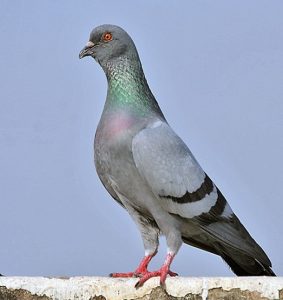
The Rock Pigeon is a large dove common in cities, farmland, and on grain elevators around the world. Wild Rock Pigeons often nest on cliffs, although they have readily adapted to nest on tall structures including skyscrapers and bridges. There are a wide array of feral and domestic color varieties, but most are gray. Rock Pigeons can also be completely black, white, or orangey-brown. Can be seen any time of year but most commonly seen in the summertime.
Common Name: American Kestrel
Scientific Name: Falco sparverius
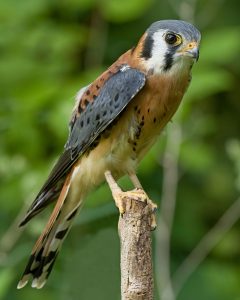
The American Kestrel is a petite falcon, roughly the same size as a Mourning Dove, but with a larger head and a wider tail. In flight, the American Kestrel has narrow wings and a square-tipped tail. It is often seen perched on telephone wires, along roadsides, and in open country with short vegetation and few trees. From a perch or hovering, they usually drop to the ground to snatch small mammals and insects. They nest in cavities such as old woodpecker holes, natural tree hollows, and rock crevices. American Kestrels are widespread across the Americas. Most commonly seen in the summertime.
Common Name: Golden Eagle
Scientific Name: Aquila chrysaetos
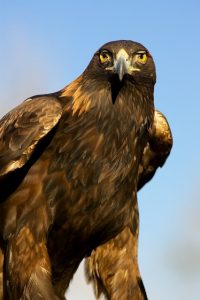
The Golden Eagle is an uncommon raptor across much of the Northern Hemisphere. It preys mainly on small mammals. The Golden Eagle is mostly dark brown with immature birds displaying a white patch on the underwing and a white tail base. It often holds its wings in a slight V-shape when soaring. Most commonly seen in the wintertime.
Common Name: American White Pelican
Scientific Name: Pelecanus erythrorhynchos
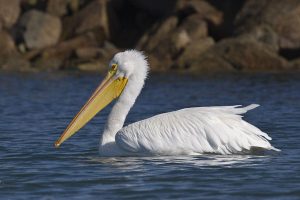
The American White Pelican is an extremely large and conspicuous bird. It is white with black wingtips. The most notable feature of the White Pelican is a very long, orange bill with a pouch for scooping up fish. It typically forages in flocks, swimming together to concentrate fish in a localized area. The White Pelican often flies in a flock formation, infrequently flapping, during migration and when traveling between feeding sites. Most commonly seen in summer along the Snake River and marsh-like areas.
Common Name: Mallard
Scientific Name: Anas platyrhynchos
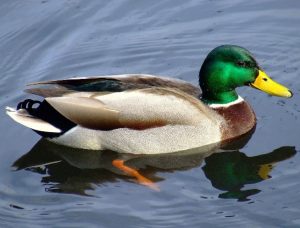
The Mallard is found anywhere with water, including city parks, backyard creeks, and various wetland habitats. Males have a green head, chestnut breast, and a gray body. Females are mottled brown with orange and black splotches on the bill. White wing bars on the front and trailing sides of the blue wing patch are bolder on the Mallard compared to those on American Black Duck and Mottled Duck.Commonly found on or along the Snake River and marsh-like areas. Most commonly seen in the summertime.
Common Name: Canyon Wren
Scientific Name: Catherpes mexicanus
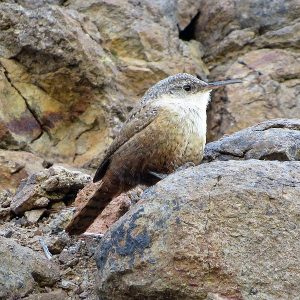
Subtly beautiful, the Canyon Wren is found in picturesque canyon-lands and rocky outcroppings of the western United States and Mexico. It is an exceptional songster and is most often located by a rich cascading song, or harsh call notes. The Canyon Wren has an orangey-brown body with tiny black-and-white spots, a bright white throat, and a thin decurved bill. The Canyon Wren is very similar to the Rock Wren but with a more contrasting white throat. You can usually spot it on the ground or cliffs, running up and down rocks, repeatedly disappearing from view only to suddenly pop up atop a lookout. The Canyon Wren primarily feeds on insects and will nest in crevices or under ledges on a cliff. Take a look at the canyon walls, this is their favorite place to nest. Most commonly seen in the summertime.
Common Name: Black-Billed Magpie
Scientific Name: Pica hudsonia
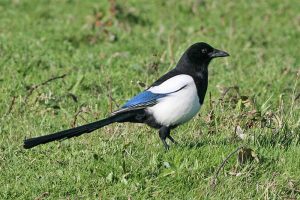
The Black-billed Magpie is a conspicuous, large black-and-white relative of crows and jays. It is often spotted along roadsides in open country, towns, and fields. The exceptionally lengthy tail is longer than the rest of the body. Black-billed Magpies are social and inquisitive. They often gather in groups to feed on carrion.Often found around dairies and farms. Commonly seen year-round.
General Name: Yellow Bellied Marmot
Scientific Name: Marmota flaviventris
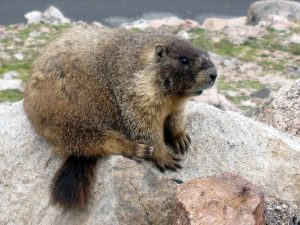
Marmots are large burrowing rodents, about the size of a house cat, found in the Northern Hemisphere. Yellow-Bellied Marmots are mammals with grizzled brownish fur, a yellow belly, and a whitish spot between the eyes. They have small round ears, a short white muzzle and black nose. Their body is heavy-set with short legs and a furry reddish-brown tail. They hibernate from September to May, although hibernation length varies with elevation.
General Name: Cliff Chipmunk
Scientific Name: Tamias dorsalis
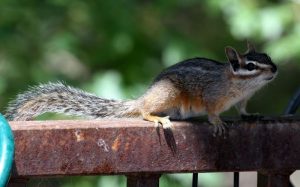
Cliff Chipmunks are small, bushy-tailed squirrels. They are brown on their underside and gray on the back with white stripes on their face. Their tails are black on top and cinnamon brown underneath.They range from southern Idaho through Arizona and western New Mexico in the United States.
General Name: Northern Pocket Gopher
Scientific Name: Thomomys talpoides
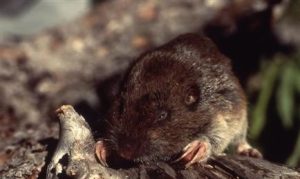
The Northern Pocket Gopher, named for its large, external, fur-lined cheek pouches, measures about 8 inches length in total, with a short, nearly hairless tail. It has soft reddish-brown upper fur and a dark gray underside. It is equipped with long curved claws on three digits of its forepaws and sharply curved, always exposed, yellowish incisors for digging and cutting.
General Name: Mountain Cottontail Rabbit
Scientific Name: Sylvilagus nuttalli
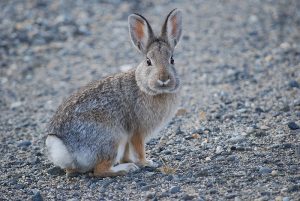
The Mountain Cottontail Rabbit inhabits brushy or wooded areas on slopes or riverbanks that are often covered with grass, willow, and most importantly, sagebrush. If vegetation is sparse, these rabbits can hide in burrows or rock crevices. The Mountain Cottontail is of medium large size with long hind legs and a large tail that is dark on top and light below. The top of the body is covered in grayish brown fur, and the underbelly is white. The hind legs are covered with reddish brown hairs that are long and dense.
General Name: River Bluet
Scientific Name: Enallagma anna
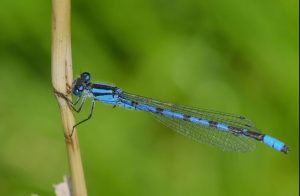
River Bluets prefer slow streams and small rivers mostly in open country but having a wetland component. These habitat types are often associated with an outflow of warm springs. The River Bluet is the only species of Enallagma that is restricted to streams and rivers. Other bluets are more commonly associated with lakes and ponds. This damselfly will eat almost any soft-bodied flying insect including mosquitoes, flies, small moths, mayflies, and flying ants or termites.
General Name: Differential Grasshopper
Scientific Name: Melanoplus differentialis
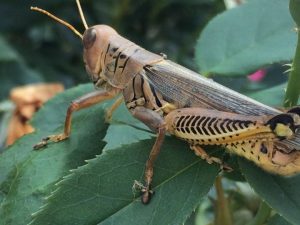
This grasshopper has distinguishing chevron stripes on its thighs. The black pattern is not unique to this species, but it is rare to see on other grasshoppers. Their back legs also have spines on them. They have short, horned antennae and produce a buzzing noise by rubbing their hind wings against their forewings.
General Name: Paper Wasps
Scientific Name: Vespidae
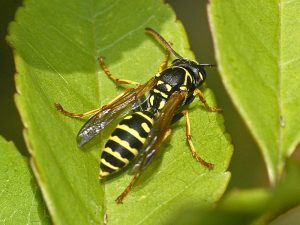
Paper wasps are striking in appearance and are about 16 mm (0.63 inch) long, with orange antennae, wings, and tarsi. The body may be jet black or brown with narrow yellow bands and paired segmental spots. The sting is painful but less toxic to humans than that of the more familiar species of wasps and hornets. The nest is made of a paper like material, fashioned from wood that the females have chewed from dead trees, fence posts, or unpainted building lumber and mixed with saliva to form a paste.
General Name: Yellow Jacket
Scientific Name: Vespula
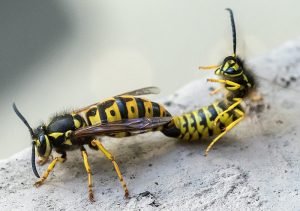
Yellow jackets, wasps, and hornets, may look alike and have similar characteristics, but they can be very different in their level of aggressiveness and their habits. It is important to properly identify the type of stinger before attempting any type of control. Yellow jackets get their common name from their typical black and yellow color pattern banded across their abdomens. They are primarily flying insects, similar to bees, but are more noticeably segmented with a very small waist.
General Name: Western Fence Lizard
Scientific Name: Sceloporus Occidentialis
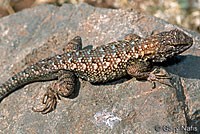
These lizards have overlapping, pointed scales. They have these “spiny” scales on their backs and limbs. The scales are even on the posterior of their legs. They can usually change their skin color to match the ground color to some degree. The ground color of their skin is broken up by black wave lines or splotches. These reptiles vary in color depending on if the lizard is a male, female or juvenile. Females and juvenile lack the throat patch and the belly patches that males have. They eat beetles flies, caterpillars, ants, spiders, and other insects.
General Name: Western Skink
Scientific Name: Plestiodon Skiltonianus
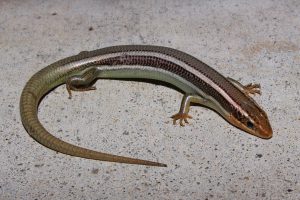
Western Skinks are small, smooth-scaled lizards with short limbs. Their body is around 2 to 3 inches long and their bright blue tail is around 1.5 to 2 times its body length. Alternating darker brown or black stripes and lighter cream or gray stripes run along the length of their body. Their underside is light-colored and has no markings. Western Skinks eat a wide variety of foods, including crickets, beetles, flies, grasshoppers, spiders, and earthworms.
General Name: Prairie Rattlesnake
Scientific Name: C. Viridus
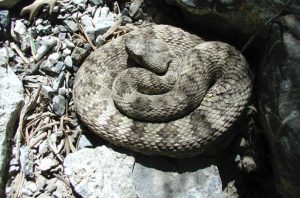
Rattlesnakes are not aggressive and will not attack humans if unprovoked; in fact, they are quite shy and timid. However, they are venomous and can be dangerous if handled.Rattlesnakes cannot tolerate extreme heat or cold. During the heat of the day, rattlesnakes hide themselves underground in burrows or under rocks. Most rattlesnakes live in arid habitats and are nocturnal, hiding during the day but emerging in the evening or at twilight to hunt for prey, which consists primarily of small mammals, especially rodents. Young and small rattlesnakes feed largely on lizards.
